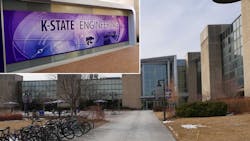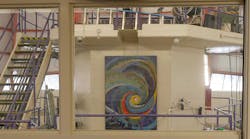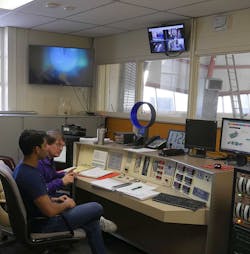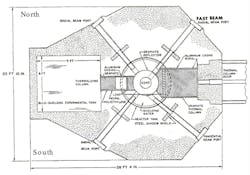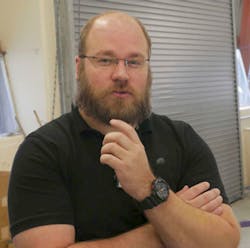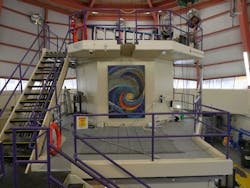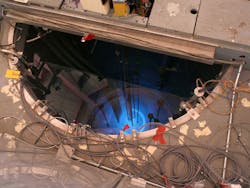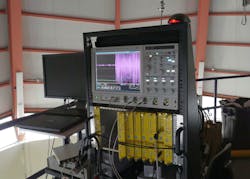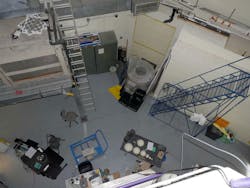In February of 2018, I visited the nuclear reactor building at Kansas State University in Manhattan, Kansas (Fig. 1). I had stopped off in Kansas to visit analog aficionado Arlie Stonestreet II on my way to the 2018 Analog Aficionados party in Silicon Valley. Stonestreet is chief engineer at Ultra ICE and an alumni of KSU.
1. The view from the control room of the KSU TRIGA nuclear reactor is an impressive sight.
The Nuclear Regulatory Commission (NRC) chartered the KSU reactor to provide an educational facility for all students at KSU and nearby universities and colleges. The charter also provides for an irradiation facility for KSU researchers and others in the central United States. In addition, it offers a facility for training nuclear-reactor operators. Finally, it’s a demonstration facility to increase public understanding of nuclear energy and nuclear-reactor systems.
The reactor was built by General Atomics. Called TRIGA (training, research, isotopes, General Atomics), students and researchers can use the reactor to study irradiation, instrumentation, and nuclear physics. The control panel is attended by pre-qualified and trained students as well as instructors and researchers (Fig. 2).
2. Robert Lee Seymour IV and a KSU student man the control panel at the TRIGA research nuclear reactor.
Safety First
The reactor has a continuous thermal output capability of 1.25 MW, and can pulse to 1,340 MW. It’s inherently safe. The fuel rods are made from uranium zirconium hydride (UZrH). The rods have a thermal-limiting mechanism where the hotter they get, the less reactive they become. When the output power is pulsed, the power will reduce to safe levels within a few milliseconds. Built in 1962, the reactor has plenty of reinforced concrete for safety and containment (Fig. 3). When first built, the reactor had a 100-kW output.
3. The KSU nuclear reactor is housed in a large concrete vessel. It’s not a containment vessel as the reactor is inherently safe. (Courtesy of Nuclear Regulatory Commission)
The reactor has both radial and tangential ports for experiments (Fig. 4). There’s also an experimental tank, as well as the graphite thermal column behind a six-foot-thick concrete door. When I asked if the thermal column was to remove heat, Robert L. Seymour, the KSU reactor supervisor, noted, “The word thermal in thermal column is probably a bit misleading. The word refers to the energy of neutrons encountered in that area, not a place to remove heat from the core.” The graphite thermalizes the neutrons to a specific energy.
4. A plan view of the KSU nuclear reactor shows the ports and pools available for experimenters. (Courtesy of Nuclear Regulatory Commission)
Taking the Grand Tour
Surrounding the reactor are the systems for maintenance and experimentation (Fig. 5). Note the KSU Wildcat logo on the access panels. KSU has one of the best basketball teams in the country. The men’s team is pretty good, too.
5. To the right side of the reactor vessel are facilities for maintenance and scientific experiments. The logo is that of the KSU Wildcats.
Seeing all of this expensive gear made me long for my college days, where there were millions of dollars of equipment available for any student who asked. I remember doing voltage contrast electron microscopy on a 74L74 flip-flop. I don’t think I will ever have a scanning electron microscope in my home lab. Students, play with that stuff while you have the chance. Here's a video that takes a quick look at voltage contrast in a such a microscope:
The tour of the facility was conducted by Steve Bellinger (Fig. 6), who is the president and CEO of Radiation Detection Technologies Inc. He followed strict protocols on the tour. Everyone got clip-on dosimeters to wear, which he logged in and out on a lab record book.
6. Steve Bellinger has the PhD radiation brains to understand and make use of the nuclear reactor at Kansas State University.
The view inside the reactor room is even more impressive (Fig. 7). The reactor exhibits both permanence and cutting-edge science at the same time. The artwork on the side of the reactor vessel is appropriate, adding to the wonder engendered by the facility.
7. The KSU nuclear reactor vessel has access stairways to the top of the water pool. In the foreground is the experimental tank covered with grates. The presence of a life preserver gives one pause for imagination.
Inside the Reactor Core
The pool around the fuel rods glows blue due to Cherenkov radiation (Fig. 8). This is caused by electrons from the fuel rods traveling faster than the speed of light in water, about 0.75c. The emission spectrum is proportional to frequency; most of the light is in the ultraviolet spectrum. Our eyes are more sensitive to blue than violet, so we see a blue glow. Like many discoveries and inventions, it was not the work of just one person. Oliver Heaviside predicted it in 1888. Madame Curie noted the glow in 1910, as did Lucien Mallet in 1926. Cherenkov observed and wrote it up in 1934, but he offered no explanation. It was his associates Igor Tamm and Ilya Frank that offered a theory of the blue glow in 1937.
8. The core of the reactor glows blue due to Cherenkov radiation. This is from beta rays propagating faster than the speed of light in water.
The upper deck of the reactor had a beautiful Tektronix scope and a set of mesytec amplifier modules (Fig. 9). The Tek DPO7104 has a 1-GHz bandwidth and a 20-Gsample/s sampling frequency. A used one on eBay will set you back $7,800. An old analog dog like me loves that big screen. Germany-based mesytec makes readout systems and electronics for neutron detectors, silicon strip detectors, and photo-multipliers.
9. The top deck of the reactor has some impressive instrumentation. Laptops have become ubiquitous as a data-gathering tool.
The left side of the reactor building has more experiments and containment vessels (Fig. 10). General Atomics has built 66 TRIGA reactors in 24 countries. Thermal power levels vary from 20 kW to 16 MW. Some have a pulse power capability of 22,000 MW. General Atomics built the first TRIGA reactor in 1958.
10. The left side of the TRIGA reactor room has more experiments and storage facilities.
Much Ado About Nothing
My favorite KSU reactor tidbit was a horrid piece of journalism by two ABC interns that thought they found a security scoop about how easy it was to tour the facility. It turns out the joke was on them: They thought the KSU students were being flirtatious, when in reality the FBI had asked the students to get a picture of the two reporters, since they had been going to several nuclear facilitates. The installation is not guarded and top-secret—its charter is to educate the public. Being inherently safe and having no plutonium, it’s not very useful to terrorists.
The university itself has a great video about the facility.:
Regarding the ABC article, Stonestreet noted, “They still give public tours of the reactor to this day. In fact, the KSU “Open House” is this weekend and they will be giving public tours all day long—how [ABC] tried to blow this into an epic scandal is almost beyond belief.” Heck, for $225 an hour, you can use the dang facility. Needless to say, ABC never retracted, corrected, or apologized for the article.
Beware and Be Aware of Hype
It reminded me of when NBC did an “expose” on Chevy trucks catching fire and it turned out they had to strap burning flares to the frame to get the video. With sloppy reporting, ABC jumped on the burning car bandwagon a couple years ago.
Then again, cruise-control switch design defects can cause cars to burn. Don’t forget those Ford ignition switches that immolated over 2000 cars. The Center for Auto Safety, founded by Ralph Nader, noted, “...a report by United Technologies Research Center that lists the ‘major cause’ of the ignition switch fires as ‘electrical erosion due to inductive loads in circuits carried through the ignition switch.’ The arcing caused by actuating the switch melts a minute amount of copper from the terminal. The stray copper then embeds itself in the Minlon® insulator and after many cycles, causes a direct B+ [battery] to ground short.”
Maybe we should all think of the design care and inherent safety of the KSU nuclear reactor when we design our electrical and electronic systems. We know we won’t get a fair shake in the popular media.
About the Author

Paul Rako
Creative Director
Paul Rako is a creative director for Rako Studios. After attending GMI (now Kettering University) and the University of Michigan, he worked as an auto engineer in Detroit. He moved to Silicon Valley to start an engineering consulting company. After his share of startups and contract work, he became an apps engineer at National Semiconductor and a marketing maven at Analog Devices and Atmel. He also had a five-year stint at EDN magazine on the analog beat. His interests include politics, philosophy, motorcycles, and making music and videos. He has six Harley Sportsters, a studio full of musical instruments, a complete laboratory, and a video set at Tranquility Base, his home office in Sun City Center Florida.
